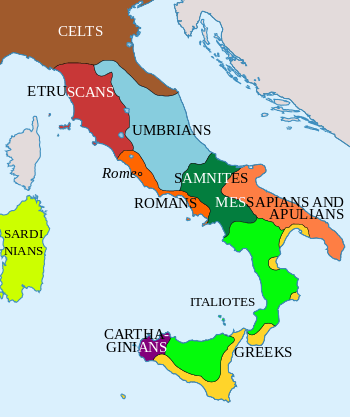Osco-Umbrian languages
| Osco-Umbrian | |
|---|---|
| Sabellian | |
| Geographic distribution: | Ancient south and central Italy |
| Linguistic classification: |
|
| Glottolog: | sabe1249[1] |
|
Approximate distribution of languages in Iron Age Italy during the sixth century BC | |
Osco-Umbrian, Sabellian or Sabellic languages is a group of Italic languages, a group of Indo-European languages that were spoken in Central and Southern Italy before Latin replaced them as the power of Ancient Rome expanded. The languages are known almost exclusively from inscriptions, principally of Oscan and Umbrian, but there are also some Osco-Umbrian loanwords in Latin.
Languages
Umbrian, Volscian, Sabine, South Picene, Marsian, Paelignian, Hernican, Marrucinian, Oscan, Pre-Samnite have been attested.
Aequian and Vestinian may also have been part of this group.
These have traditionally been ascribed to an Oscan group or an Umbrian group. However, they are all poorly attested, and such a division is not supported by the evidence. It appears that they may have formed a continuum, with Umbrian in the north, Oscan in the south, and the 'Sabellic' languages in between (see next section) having features of both.[2]
Past usage
Sabellic was originally the collective ethnonym of the Italic people who inhabited central and southern Italy at the time of Roman expansion. The name was later used by Theodor Mommsen, in his Unteritalische Dialekte to describe the pre-Roman dialects of Central Italy that were neither Oscan nor Umbrian.
The term is is currently used for the Osco-Umbrian languages as a whole. The word "Sabellic" was once applied to all such minor languages, Osco-Umbrian or not. Even North Picene was included, but it was always known to have been unrelated to the languages to which the word is now applied.
Differences from Latin
Although the Osco-Umbrian languages are far more poorly attested than Latin, a corpus of a few thousand words' worth of inscriptions has allowed linguists to deduce some cladistic innovations and retentions. For example, while Proto-Indo-European aspirates appear as b, d, and h/g between vowels in Latin (medius < *medʰyos), in Sabellic these aspirates all appear as f (Oscan mefiai). In addition, while Latin retained the Proto-Indo-European labiovelar series ("Q-Italic"), the Osco-Umbrian languages merged them with the labials ("P-Italic"): Latin quattuor, Oscan petora.
References
- ↑ Hammarström, Harald; Forkel, Robert; Haspelmath, Martin; Bank, Sebastian, eds. (2016). "Sabellic". Glottolog 2.7. Jena: Max Planck Institute for the Science of Human History.
- ↑ Rex Wallace, 2008, "Sabellian Languages", in Woodard, ed., The Ancient Languages of Europe, CUP, p 98
External links

Wikisource has the text of the 1911 Encyclopædia Britannica article Sabini.
